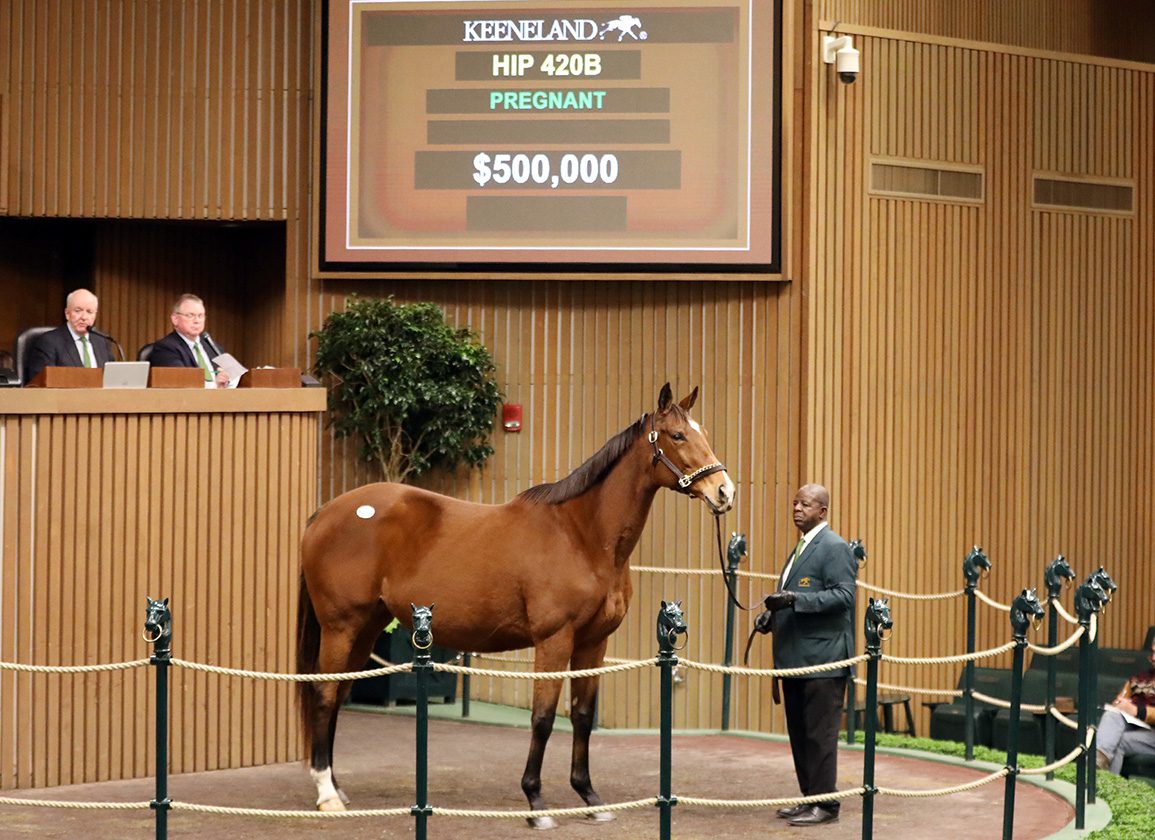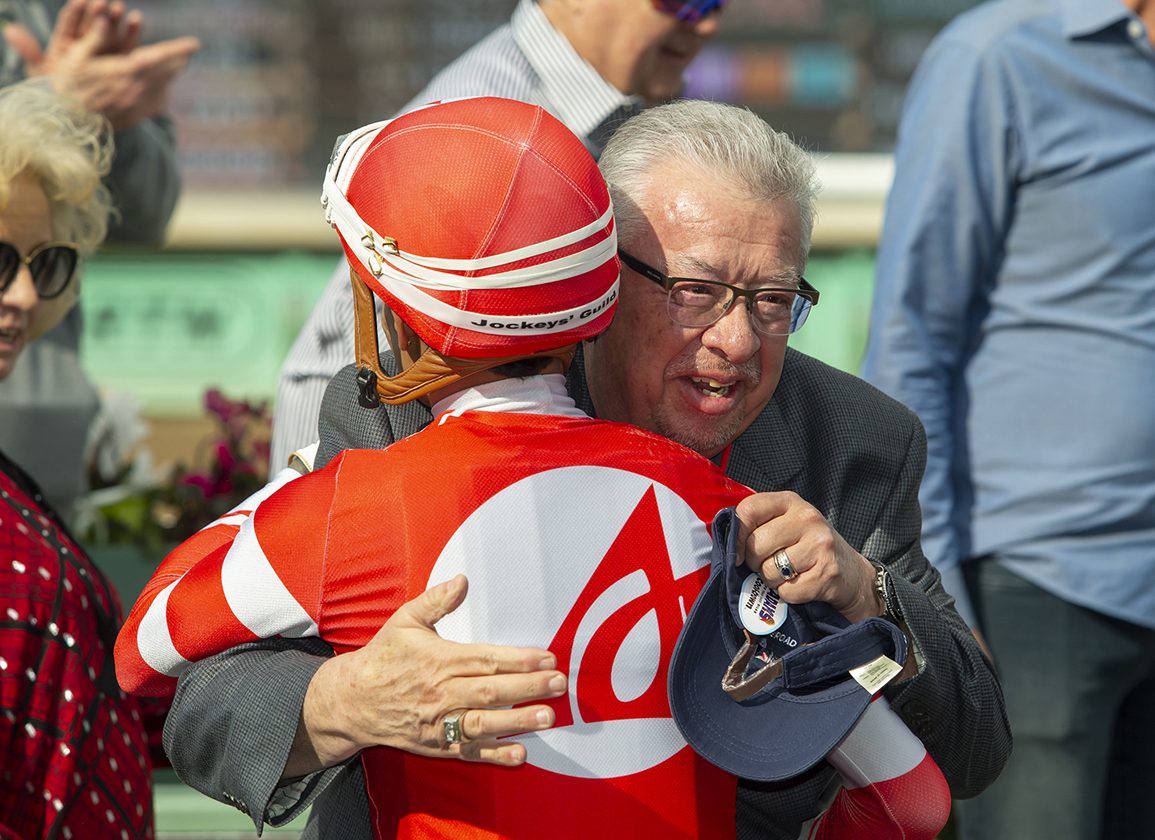Pierre Jean Amestoy Jr. has never been to the Kentucky Derby. Not even as a spectator. However, the 2023 renewal may very well change that fact after Practical Move (Practical Joke), who he owns in partnership with his wife Leslie and Roger Beasley, stamped himself a major Classic contender with a victory in last weekend's GII San Felipe S. at Santa Anita.
“My wife and I were very emotional after the win,” said Pierre Amestoy. “It was phenomenal. It was exhilarating. We're just elated.”
“I guess we're heading to the Kentucky Derby!” he laughed.
Adding some dramatic flavor to the story, the Amestoy's trainer, Tim Yakteen, had just taken over several of Bob Baffert's Classic contenders, including three colts that would make it into the San Felipe lineup on race day.
Was Amestoy worried?
“It was all about the trip,” he said. “As long as we didn't get stopped, or bumped or fall down out of the gate. It was more about something silly happened rather than fearing any of the other horses.”
He added, “Tim told us that this horse has been maturing and coming along, getting stronger and better. We were really confident in our horse going into the race.”
“He will point him toward the Santa Anita Derby [Apr. 8], that is the right progression. Hopefully, everything goes good there and then on to the Kentucky Derby. And if we can get a good trip there and get up to the top third of the pack, then I think we have a real chance. I think our style has been working and I think it often works in the Kentucky Derby too.”
Coming up Aces in the First Sales Foray
Up until last year, the Amestoys bred their own state-foaled runners at their five-acre farm in Albuqurque, New Mexico. However, once they determined they wanted to dive into the 2-year-olds in training sales scene, and branch out beyond the New Mexico racing scene, it didn't take long to hit paydirt.
Teaming up with Beasley last spring at the OBS Spring Sale, the Amestoys extended to $230,000 for the son of Practical Joke, who was represented by his first 3-year-olds in 2022. The final price represented the second highest priced offspring by his sire at that venue. Offered as Hip 97 by Eisaman Equine, the late Apr. 30 foal covered an eighth of a mile in :10.1 during the breeze show.
“That was the only box we could not check,” said Amestoy of the late foaling date. “We much would have preferred to have had a Feb. 30 colt than an April foal. But physically, he didn't look behind. Yes, it was a concern at first, but Tim said, “let him take us there.” If we needed to, we were prepared to back off and wait. We let him tell us.”
Extolling the colt's virtues, he continued, “He was never undersized and we could see the maturity in him even at that point. He was big enough, he had enough bone and a great foot. He had the scope and the walk. Most importantly, he had the mentality. We went and saw him every day we were there. We watched him and we thought there would be room to improve being that he was young.”

Ack Naughty selling at the 2023 Keeneland January Horses of All Ages Sale | Keeneland
Adding some nuance to the colt's page, New York-based Ack Naughty had amassed over $300,000 during her racing career while competing mainly on the turf for Sol Kumin and partners and trainer Chad Brown, who had Practical Joke in the barn at the same time. Later combining their resources when both sire and dam had retired, Brown and Kumin are registered as the colt's breeders
After producing a Complexity colt in 2022, Ack Naughty sold for $500,000 at this year's Keeneland January sale, however, the foal she was carrying at the time was stillborn. Practical Move is from the family of champion Vino Rosso.
“We liked his sire because he was a speed sire,” he said. “He was a good miler and a three-time Grade I winner and by one of the hottest horses in the world, Into Mischief. So the top side was strong. On the bottom, we liked that the mare was stakes placed and earned over $300,000. She is by Afleet Alex, so there was distance there. We were hoping that the top side would bring the speed and the bottom side the stamina. So this time, it looks like it worked out.”
Once hitting the racetrack, Practical Move showed talent early, finishing second behind the Bob Baffert-trained Cave Rock (Arrogate)–a subsequent dual Grade I winner–going 6 1/2 furlongs in his debut at Del Mar before finishing third next time over that same track and distance. Second under the wire but later promoted to first after the disqualification of Baffert trainee Fort Bragg (Tapit) while stretching to a mile at Santa Anita last October, he was third behind two more Baffert runners–Havnameltdown (Uncaptured) and Newgate (Into Mischief)–in the seven-panel GIII Bob Hope S. at Del Mar Nov. 20. Given one more start at two, the bay proved an easy winner of the 1 1/16-mile GII Los Alamitos Futurity Dec. 17.
“After the Los Alamitos Futurity we gave him a little time off, and he actually blossomed over that time,” said Amestoy. “He put on 45 pounds and he kept it. He is all muscle and has turned into an absolute specimen.”
“We've always been Thoroughbred people”
Following their latest win, much has been made of the Amestoy's involvement in Quarter Horse racing. Indeed, they have held a significant stake in the Quarter Horse industry over the past two decades, having campaigned the likes of champions First to Flash (2002) and First Moonflash (2009). However, Amestoy is quick to point out that Thoroughbreds was always the main attraction.
“Even when my wife trained in the 70s and 80s, she trained Thoroughbreds. And even today, we probably have 3 to 1 more Thoroughbreds than Quarter Horses,” said Amestoy.
He continued, “We have done very well in the Quarter Horse industry. We've had two champions, lots of graded and Grade I wins, but Thoroughbreds have always been our first play.”
Explaining the decision to venture into Quarter Horses over a decade ago, he explained, “When you race in New Mexico, there is a lot of Quarter Horse racing. So even though we were winning Thoroughbred races in New Mexico, there were still four to five races a day for Quarter Horses. So, we thought, 'Heck, why don't we play in there?' There are a lot of races and money we can be playing for and it's right at home.”

Practical Move's co-owner Pierre Amestoy, Jr. and jockey Ramon Vazquez | Benoit Photo
Following the Amestoy's marriage in 1988, the couple purchased a farm in Paris, Kentucky, Lobo Farm, while choosing to reside in New Mexico, where Pierre operated his construction and development company.
“We stood stallions, had broodmares and pinhooked yearlings, we just about did it all,” said Amestoy of his Kentucky-based operation.
Despite all their success with Quarter Horses, it was their Thoroughbred operation that yielded of the couple's biggest coups in either industry. In 2008, Irish Cherry (Irish Open) sold for $2.7 million at the Keeneland January sale. Sold in partnership with Mike Abraham, the then 14-year-old mare was best known for producing MGISW Spun Sugar and GSW Daaher.
“We bought Irish Cherry in foal to Storm Cat [for $800,000 at KEENOV in 2006] and we bred her back to Ghostzapper. We had a very nice pinhook there. We did very well at the sales. We also sold several high-dollar yearlings in Kentucky as well.”
After selling Lobo farm in 2011, the Amestoys opted to focus on their Quarter Horse operation as well as their small group New Mexico-based Thoroughbred mares, usually numbering about five to six. The resulting yearlings were sent to the Amestoy's training center next to Sunland Park, and from there, the youngsters would either go to the sales or the remain in training with the Amestoy's New Mexico-based trainer, Todd Fincher.
When asked why much of the post San Felipe news led with the narrative describing the Amestoys as 'Quarter Horse owners', he said, “We had the farm in Kentucky for 12 years. We bred there, we raced there. We've done it all there. We have a substantial background with Thoroughbreds. It's probably because this is the first time that we got to this level [in Thoroughbred racing]. But we've been doing this a long time and have been good at it.”
Sales Savvy
While all roads lead to Thoroughbreds, the Amestoy's most important Thoroughbred to date was derived through a connection made via their Quarter Horse dealings. And that important alliance spearheaded the decision to take a swing at the Thoroughbred sales in search of a Classic horse.
“After we sold our farm, we concentrated on racing in New Mexico because the purses were very good. That's when I met my current partner, Roger Beasley, through a mutual friend and we bought some Quarter Horses together. We did really well together. [Early last year, we were just talking and [Beasley] said, 'Pierre, why don't we get a couple of Thoroughbreds and let's try and go for the big races.' So I said, “I have the experience and I'll do the work.” There was a sale [OBS] coming up in Florida and Leslie and I said we would go down for a week and find a couple.”
And the venture proved fruitful.
“We went out there, and found Practical Move and we found another, Blessed Touch [Girvin], who ran third [in the GIII Santa Ysabel S.] last Sunday.”
The $140,000 OBS Spring buy, who won second time out at Santa Anita last October, subsequently finished runner up in the Desi Arnaz S., in November. Additionally, the partnership purchased a colt by Valiant Minister for $38,000 and, in conjunction with Mike Abraham, secured a $50,000 colt by Munnings, who had been slated to run on the San Felipe undercard and was scratched because of a minor issue but is expected to return.
“He appears to have some talent,” said Amestoy of the Munnings colt.
While breeding to race had been the Amestoy's M.O. for much of their past involvement in the Thoroughbred game, the sparkling success of their first foray into public sales last season makes it a safe bet that they will be returning to the well this year.
“Roger and I were just talking the other day and he asked, Partner, do you want to go back [to OBS]? In order to find another one we would have to go back!” he said with a laugh. “We might go back to OBS and sniff around and see what we can find.”

The post OBS Grad Practical Move Looking for Roses appeared first on TDN | Thoroughbred Daily News | Horse Racing News, Results and Video | Thoroughbred Breeding and Auctions.
Source of original post


